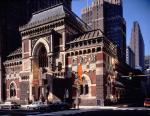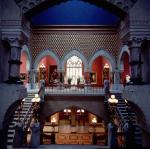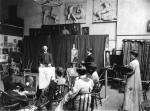![header=[Marker Text] body=[America's oldest museum and school of fine arts, founded in 1805 by painter and scientist Charles Willson Peale, sculptor William Rush, and others, the Academy collects and exhibits the work of distinguished American artists and provides studio instruction. Thomas Eakins and Violet Oakley are closely associated with the institution. The museum building is the city's most florid example of High Victorian architecture.] sign](http://explorepahistory.com/kora/files/1/10/1-A-19D-139-ExplorePAHistory-a0a9n5-a_450.gif)
Mouse over for marker text
Name:
Pennsylvania Academy of Fine Arts
Region:
Philadelphia and its Countryside/Lehigh Valley
County:
Philadelphia
Marker Location:
At the Academy, 118 Broad St., Philadelphia
Dedication Date:
November 17, 2004
Behind the Marker
Although not the first museum (Charles Willson Peale's Museum in Philadelphia, founded in 1786) or art school (The New-York Academy of the Fine Arts founded in 1802), the Pennsylvania Academy of Fine Arts (PAFA) is the oldest functioning institution in the United States in both categories.
Inspired by New York's example, Charles Willson Peale, in 1805, along with his son Rembrandt, and sculptor William Rush joined sixty-eight businessmen and lawyers to "promote the cultivation of the FINE ARTS in the United States of America, by introducing correct and elegant copies from works of the first masters in sculpture and painting and by thus facilitating the access to such standards, and also by . . . assisting the studies and exciting the efforts of the artist gradually to unfold, enlighten, and invigorate the talents of our countrymen."
Charles Willson Peale, in 1805, along with his son Rembrandt, and sculptor William Rush joined sixty-eight businessmen and lawyers to "promote the cultivation of the FINE ARTS in the United States of America, by introducing correct and elegant copies from works of the first masters in sculpture and painting and by thus facilitating the access to such standards, and also by . . . assisting the studies and exciting the efforts of the artist gradually to unfold, enlighten, and invigorate the talents of our countrymen."
Despite their pride in the new republic, American artists, like American writers, wanted to be recognized as equals by painters and connoisseurs in the intellectual capitals of Europe such as London and Paris. That great Pennsylvania artists such as Mary Cassatt and
Mary Cassatt and  Henry Ossawa Tanner, went abroad to study, and never came back, while
Henry Ossawa Tanner, went abroad to study, and never came back, while  John James Audubon and
John James Audubon and  George Catlin journeyed to France and England to sell their portfolios of birds and Native Americans, respectively, was indicative of the general belief that European audiences were more receptive to innovative American art than those at home. As a result, until the arrival of Thomas Eakins' powerful paintings of the late nineteenth century, the early twentieth century "Ashcan School" in which former illustrators' work reflected the gritty reality of city beat reporting, and the development of abstract art after that, American art was largely derivative of European.
George Catlin journeyed to France and England to sell their portfolios of birds and Native Americans, respectively, was indicative of the general belief that European audiences were more receptive to innovative American art than those at home. As a result, until the arrival of Thomas Eakins' powerful paintings of the late nineteenth century, the early twentieth century "Ashcan School" in which former illustrators' work reflected the gritty reality of city beat reporting, and the development of abstract art after that, American art was largely derivative of European.
Opened in 1805, the Academy from the start was both an art school and museum. Originally housed at Chestnut Street between Ninth and Tenth, the Academy resembled Benjamin Latrobe's neo-classical pumping station in Center Square. (That building may be seen in a painting by John Lewis Krimmel, "Fourth of July in Center Square," which the PAFA now owns.) Krimmel's lively portraits of crowds, with every figure possessing personality and all interacting in a pleasing whole, have grown in popularity as the taste for monumental historical and biblical art based on European models has declined. The PAFA's most notable - and expensive - early acquisitions were two such canvasses: Washington Allston's "The Dead Man Restored to Life by Touching the Bones of Elisha" and Benjamin West's "Death on the Pale Horse."
Benjamin West's "Death on the Pale Horse."
The Academy constructed its second building in 1845, after a lunatic burned down the first. By the 1850s, more than 13,000 visitors were paying twenty-five cents each to visit what was then America's finest gallery. Middle-class Americans craved both education and spectacle, as the popularity of traveling attractions like author Charles Dickens and P. T. Barnum's circus proved. Special exhibitions featured huge and spectacular landscapes, including works by contemporary Hudson River school landscape artist Frederic Edwin Church. While fellow New Yorker Thomas Cole displayed his monumental four-part series, "The Course of Empire" in 1858, the Academy presented more than 230 British pre-Rapahelite works organized by William Rosetti.
With outstanding painters such as Thomas Sully and Christian Schuessele on the faculty, the Academy was at the forefront in encouraging contemporary art. The Pre-Raphaelities, for example, idealized depiction of a heroic Middle Ages set the trend for a larger revival of medieval architecture and illustrations later in the century, including Pennsylvania Howard Pyle's still popular drawings of Robin Hood and King Arthur's legends.
This innovative leadership continued after 1876, when the Academy sold its decaying Chestnut Street headquarters to move into its current home at Broad and Cherry Streets. A unique building designed by Frank Furness and variously termed "High Victorian," "Venetian Gothic," or "Polychrome Picturesque," it displays the grandeur, whimsy, and stylistic eclecticism of the façade of Philadelphia City Hall and the interior rooms of the Masonic Temple, other nineteenth-century masterpieces nearby on Broad Street.
In its much-enlarged surroundings, the Academy continued to train leading artists of the new generations: Thomas Anschutz was the most distinguished of a succession of outstanding teachers that included Thomas Eakins and Cecila Beaux, while pupils included Robert Henri, William Glackens, George Luks, and John Sloan of the "Ashcan School," African-American painter Henry Ossawa Tanner, and engraver
Thomas Eakins and Cecila Beaux, while pupils included Robert Henri, William Glackens, George Luks, and John Sloan of the "Ashcan School," African-American painter Henry Ossawa Tanner, and engraver  Frank Gasparro.
Frank Gasparro.
It also bought controversial paintings including the misty and mystical works of James McNeil Whistler and George Bellow's robust portraits of working-class life. In the first decade of the twentieth century, Alfred Stieglitz exhibited pioneering modern photography that displayed the medium's artistic possibilities rather than simply duplicating reality. When New York's famous Armory Show in 1913 introduced the latest European and American art, including Cubism, to the United States, Pennsylvania's Charles Sheeler was represented there by six works. In 1921, PAFA hosted the first major all-American modern art exhibit that included works by Sheeler and by Pennsylvanians John Marin,
Charles Sheeler was represented there by six works. In 1921, PAFA hosted the first major all-American modern art exhibit that included works by Sheeler and by Pennsylvanians John Marin,  Charles Demuth, and Stuart Davis. Only the firing in 1886 of Thomas Eakins as drawing instructor for allowing nude male models to be painted by women marred the Academy's record as a trend-setter.
Charles Demuth, and Stuart Davis. Only the firing in 1886 of Thomas Eakins as drawing instructor for allowing nude male models to be painted by women marred the Academy's record as a trend-setter.
The Academy would not, however, remain at the forefront of American art. From the mid-1920s to the early 1970s the Academy favored more conservative art that offered realism and nostalgia. The summer school it opened in 1916 in Chester Springs taught students to paint traditional landscapes, figures of people and animals and buildings. After nearly a half-century of conservative management the Academy sought to reclaim its place in the vanguard of American art exhibition and education. It began an extensive conservation program in 1970, began training docents in 1972, restored the building to its original glory in 1976, and published a catalogue and history critical of its past management practices the same year.
Chester Springs taught students to paint traditional landscapes, figures of people and animals and buildings. After nearly a half-century of conservative management the Academy sought to reclaim its place in the vanguard of American art exhibition and education. It began an extensive conservation program in 1970, began training docents in 1972, restored the building to its original glory in 1976, and published a catalogue and history critical of its past management practices the same year.
In the late 20th century, the Academy mounted important shows that ranged from nineteenth century landscape art to modern realist and abstract American art. In 2004, exhibitions on abstract art in America from 1945 to the present, and "African American Artists Celebrate Community" accompanied classics from earlier periods and student expositions on display. An online website provides a comprehensive guide to the Academy's diverse activities.
Inspired by New York's example,
Despite their pride in the new republic, American artists, like American writers, wanted to be recognized as equals by painters and connoisseurs in the intellectual capitals of Europe such as London and Paris. That great Pennsylvania artists such as
Opened in 1805, the Academy from the start was both an art school and museum. Originally housed at Chestnut Street between Ninth and Tenth, the Academy resembled Benjamin Latrobe's neo-classical pumping station in Center Square. (That building may be seen in a painting by John Lewis Krimmel, "Fourth of July in Center Square," which the PAFA now owns.) Krimmel's lively portraits of crowds, with every figure possessing personality and all interacting in a pleasing whole, have grown in popularity as the taste for monumental historical and biblical art based on European models has declined. The PAFA's most notable - and expensive - early acquisitions were two such canvasses: Washington Allston's "The Dead Man Restored to Life by Touching the Bones of Elisha" and
The Academy constructed its second building in 1845, after a lunatic burned down the first. By the 1850s, more than 13,000 visitors were paying twenty-five cents each to visit what was then America's finest gallery. Middle-class Americans craved both education and spectacle, as the popularity of traveling attractions like author Charles Dickens and P. T. Barnum's circus proved. Special exhibitions featured huge and spectacular landscapes, including works by contemporary Hudson River school landscape artist Frederic Edwin Church. While fellow New Yorker Thomas Cole displayed his monumental four-part series, "The Course of Empire" in 1858, the Academy presented more than 230 British pre-Rapahelite works organized by William Rosetti.
With outstanding painters such as Thomas Sully and Christian Schuessele on the faculty, the Academy was at the forefront in encouraging contemporary art. The Pre-Raphaelities, for example, idealized depiction of a heroic Middle Ages set the trend for a larger revival of medieval architecture and illustrations later in the century, including Pennsylvania Howard Pyle's still popular drawings of Robin Hood and King Arthur's legends.
This innovative leadership continued after 1876, when the Academy sold its decaying Chestnut Street headquarters to move into its current home at Broad and Cherry Streets. A unique building designed by Frank Furness and variously termed "High Victorian," "Venetian Gothic," or "Polychrome Picturesque," it displays the grandeur, whimsy, and stylistic eclecticism of the façade of Philadelphia City Hall and the interior rooms of the Masonic Temple, other nineteenth-century masterpieces nearby on Broad Street.
In its much-enlarged surroundings, the Academy continued to train leading artists of the new generations: Thomas Anschutz was the most distinguished of a succession of outstanding teachers that included
It also bought controversial paintings including the misty and mystical works of James McNeil Whistler and George Bellow's robust portraits of working-class life. In the first decade of the twentieth century, Alfred Stieglitz exhibited pioneering modern photography that displayed the medium's artistic possibilities rather than simply duplicating reality. When New York's famous Armory Show in 1913 introduced the latest European and American art, including Cubism, to the United States, Pennsylvania's
The Academy would not, however, remain at the forefront of American art. From the mid-1920s to the early 1970s the Academy favored more conservative art that offered realism and nostalgia. The summer school it opened in 1916 in
In the late 20th century, the Academy mounted important shows that ranged from nineteenth century landscape art to modern realist and abstract American art. In 2004, exhibitions on abstract art in America from 1945 to the present, and "African American Artists Celebrate Community" accompanied classics from earlier periods and student expositions on display. An online website provides a comprehensive guide to the Academy's diverse activities.
Beyond the Marker








